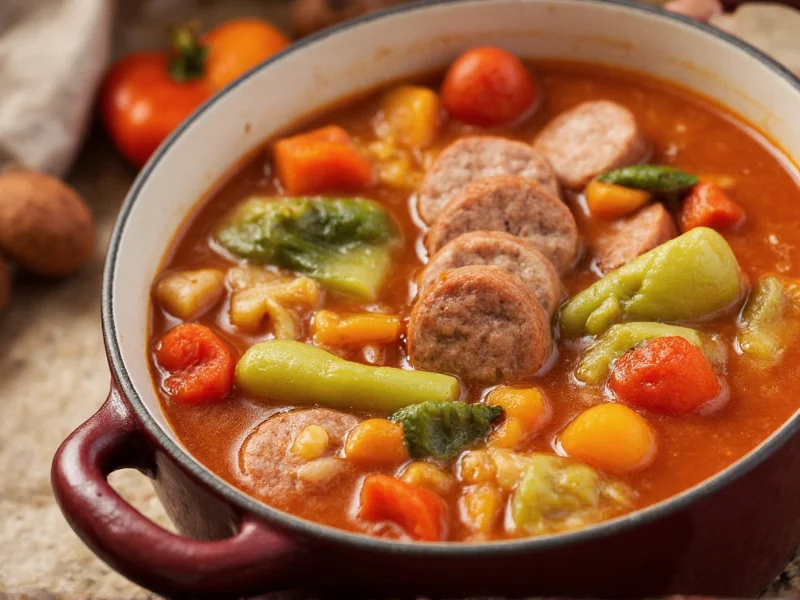Sausage vegetable soup represents one of the most versatile comfort foods that combines protein-packed sausage with nutrient-dense vegetables in a single simmering pot. This classic preparation method creates a satisfying meal that's both nutritionally balanced and adaptable to various dietary preferences. Whether you're looking for an easy sausage vegetable soup recipe for weeknight dinners or a healthy sausage and vegetable soup option for meal prep, this dish delivers exceptional flavor with minimal effort.
Essential Ingredients for Perfect Sausage Vegetable Soup
The foundation of any exceptional sausage vegetable soup starts with quality ingredients. While regional variations exist, the following components create a balanced flavor profile that satisfies most palates:
| Ingredient Category | Specific Items | Quantity for 6 Servings |
|---|---|---|
| Protein | Italian sausage (mild or hot) | 1 pound |
| Aromatics | Yellow onion, garlic cloves | 1 large, 3-4 cloves |
| Root Vegetables | Carrots, celery stalks | 3 medium, 3 stalks |
| Tomato Base | Crushed tomatoes, tomato paste | 1 (28oz) can, 2 tbsp |
| Leafy Greens | Kale or spinach | 4 cups chopped |
| Broth | Chicken or vegetable broth | 6 cups |
Step-by-Step Cooking Instructions
Creating a homemade sausage vegetable soup that rivals restaurant quality requires attention to cooking sequence and timing. Follow these professional techniques for optimal results:
- Brown the sausage properly: Remove casing from Italian sausage and break into small chunks. Cook in large pot over medium-high heat until well-browned (about 8 minutes). Proper browning creates fond (those browned bits on the bottom) which adds tremendous flavor.
- Sweat aromatics: Add diced onion and minced garlic to the pot with sausage. Cook until translucent (5-7 minutes), scraping up any fond from the bottom of the pot.
- Build flavor base: Stir in tomato paste and cook for 2 minutes until it darkens slightly. This step caramelizes the sugars in the paste, creating deeper flavor.
- Add liquids and hard vegetables: Pour in broth and crushed tomatoes, then add chopped carrots and celery. Bring to a gentle boil, then reduce heat to low.
- Simmer to perfection: Cover and simmer for 20 minutes until vegetables reach desired tenderness. Avoid boiling vigorously as this can make vegetables mushy.
- Incorporate delicate ingredients: Stir in chopped kale or spinach during the last 5 minutes of cooking. This preserves texture and vibrant color.
- Season and finish: Adjust salt and pepper to taste. For a creamy sausage vegetable soup variation, stir in 1/2 cup heavy cream or coconut milk at the end.
Nutritional Benefits and Dietary Adaptations
This healthy sausage and vegetable soup delivers impressive nutritional value while remaining incredibly adaptable. A standard serving (1.5 cups) typically contains:
- Calories: 320-380
- Protein: 22-26g
- Fiber: 6-8g
- Vitamin A: 120% of daily value
- Vitamin C: 45% of daily value
- Iron: 20% of daily value
For those seeking a low calorie sausage vegetable soup, consider these modifications:
- Use turkey or chicken sausage instead of pork varieties
- Reduce sausage quantity by 25% and increase vegetable content
- Substitute half the broth with water
- Add extra leafy greens for volume without significant calories
Expert Tips for Superior Results
Professional chefs employ several techniques to elevate a basic easy sausage vegetable soup recipe into something extraordinary:
- Acid balance: Finish with a splash of red wine vinegar or lemon juice to brighten flavors
- Texture contrast: Reserve some vegetables for adding in the last 5 minutes for varied texture
- Flavor layering: Deglaze the pot with 1/4 cup dry white wine after browning sausage
- Herb infusion: Add a Parmesan rind while simmering for umami depth (remove before serving)
- Time management: Prepare all ingredients before starting (mise en place) for efficient cooking
Variations for Different Dietary Needs
The versatility of sausage vegetable soup makes it ideal for accommodating various dietary preferences. Consider these adaptations for specific needs:
- Vegetarian version: Substitute plant-based sausage and vegetable broth for a satisfying vegetarian sausage vegetable soup
- Gluten-free: Naturally gluten-free when using certified GF sausage and broth
- Keto adaptation: Increase sausage quantity, reduce carrots, and add extra healthy fats like olive oil
- Spicy variation: Use hot Italian sausage and add red pepper flakes during cooking
- Mediterranean twist: Incorporate olives, artichoke hearts, and fresh oregano
Storage and Reheating Guidelines
One of the greatest advantages of this freezer-friendly sausage vegetable soup is its excellent storage properties. Follow these recommendations for optimal freshness:
- Refrigeration: Store in airtight container for up to 5 days
- Freezing: Portion into freezer-safe containers with 1-inch headspace for expansion; maintains quality for 3 months
- Reheating: Thaw overnight in refrigerator, then warm gently over medium-low heat (avoid boiling)
- Revitalizing: Add a splash of fresh broth when reheating to restore optimal consistency
Serving Suggestions for Complete Meals
While sausage vegetable soup stands beautifully on its own, these pairing suggestions create restaurant-quality meals at home:
- Crusty whole-grain bread or garlic bread for dipping
- Simple green salad with lemon vinaigrette
- Grated Parmesan cheese for topping
- Crusty baguette slices rubbed with garlic
- Light pasta side (like orzo or small shells)











 浙公网安备
33010002000092号
浙公网安备
33010002000092号 浙B2-20120091-4
浙B2-20120091-4